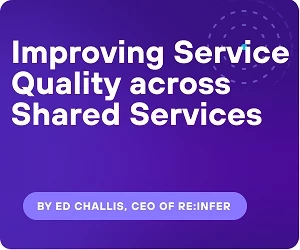
Shared services and global business services (GBS) played an instrumental role in shoring up business resilience during the most difficult days of the pandemic. However, priorities are shifting in the aftermath.
Increased pressure is being put on the heads of change, innovation and business transformation to deliver sizable, positive change at scale. There are also growing expectations for intelligent automation to contribute real business value through new services that help employees work better and more efficiently.
The challenge is that many of the most obvious automation opportunities have seemingly already been realised using the existing toolset around intelligent automation. To drive further value, change leaders will need to go outside of their comfort zone and interrogate their current strategies. It’s crucial they discover new ways to uncover more valuable transformation opportunities while also getting more out of existing automations.
The first step is identifying the gaps in your approach - the areas and processes where untapped value awaits.
RPA: A missed opportunity?
Robotic Process Automation (RPA) has been one of the most popular and transformative intelligent automation solutions leveraged in shared services. Indeed, insight from Deloitte shows that almost three-quarters (72%) of shared services and GBS organisations have already implemented RPA to automate inefficient manual processes - freeing agents for more valuable tasks, and enabling faster straight-through processing.
However, reality often disappoints expectations of change and business value. RPA projects often fail to deliver the scale of change expected and maintain continuous improvement year on year. Nearly half (46%) of shared service functions which have deployed RPA see less than 10% in savings. Service agents, meanwhile, continue to struggle with the sheer volume of inbound requests, gaining little of the time back needed to take on new services.
RPA initiatives deliver critical improvements to process efficiency. Yet there is so much more that they should be achieving. For those failing to see significant savings, siloed automations (41%) and process technical complexity (43%) are the biggest challenges. Intelligent automation leaders lack complete visibility over their end-to-end processes, leaving little choice but to automate the more obvious but lower-value workflows.
Structured data flows aren’t the problem. Tools like ERP, Process Mining, Task Mining and RPA can easily give transformation leaders the ability to analyse and action structured data. The gap in intelligent automation strategies is unstructured data. This represents 80% to 90% of all data in the average enterprise, but transformation leaders for the most part lack any intelligence into this massive data source. Furthermore, RPA is powerless to automate any process that depends on it.
Unstructured data describes a plurality of different data types - everything from digital documents to videos and notes logged in ERP systems. In recent years, tools like optical character recognition and intelligent document processing have emerged which convert unstructured documents and images into structured, machine-readable data. However, the single most prevalent and important source of unstructured data remains mostly untouched - email.
The cost of communications
Shared services and GBS run on communications. Almost every workflow is triggered by an email between colleagues or inbound from a client. Email is how information is shared and people work together - it’s embedded in all processes.
However, email is also very inefficient. Many emails have to be triaged before they reach their correct destination, and this needs to be done manually with some people whose only role in the process is to forward emails along the chain. In another example, when a request without a clear owner lands in a shared mailbox, time-poor agents will ignore it until someone else picks it up.
For the most part, manual email processing is a low-skill and repetitive task. But the sheer volume of requests means that the average employee sends or receives 126 emails a day, with 40% of their time spent in Outlook alone. Indeed, 30% of employees view email as their biggest distraction from ‘real’ work.
Given the level of inefficiency and process breakdown it causes, manual email processing should be a rich vein for intelligent automation and RPA opportunities. However, email is largely immune to traditional intelligent automation tools. The important information contained in emails is expressed in natural conversational language. This is something machines have long struggled to process. Without a foundation of structured data there’s little a BPM tool can understand, or an RPA software robot automate, from an email conversation.
The prevalence of email then presents a major problem for heads of IA, change and transformation. Automation decisions need to be backed up by data, but leaders can’t understand, track or quantify what tasks are taking up the most capacity. At the same time, automation tools need clean, structured data in order to achieve straight-through processing. But this isn’t possible when every manual process is hidden behind a wall of emails.
As a result, email-based processes remain the gap or missing piece in intelligent automation. Change leaders are restricted to making improvements at the tail end of processes, lacking insight into the very processes where the bulk of latency occurs.
Closing the gap
Email has long been a blindspot for transformation leaders. However, until they bridge this gap in analysis and automation they will struggle to achieve changes with impact that are scalable and which deliver continuous improvement.
Fortunately, natural language processing (NLP) has advanced greatly in recent years and gives intelligent automation leaders a reliable and effective solution for transforming unstructured email communications into structured, machine-readable data.
Find out more about how NLP and Communications Mining are solving the email challenge.



















